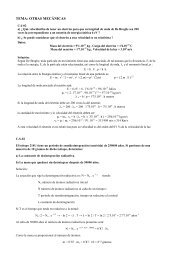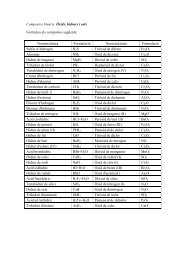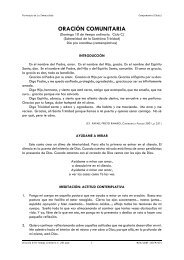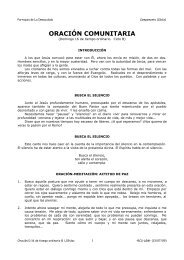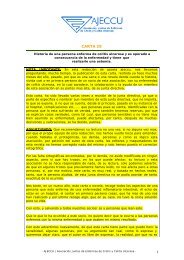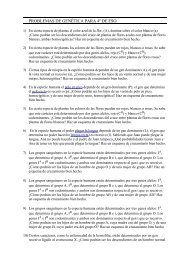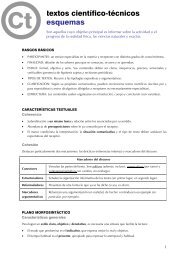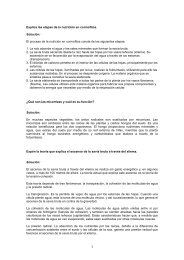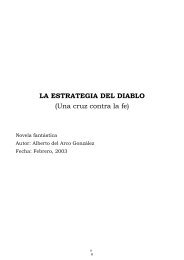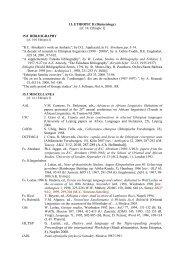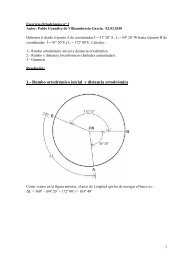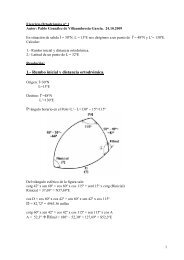BIB-SEM.6HB-dial _2010 - Telefonica.net
BIB-SEM.6HB-dial _2010 - Telefonica.net
BIB-SEM.6HB-dial _2010 - Telefonica.net
You also want an ePaper? Increase the reach of your titles
YUMPU automatically turns print PDFs into web optimized ePapers that Google loves.
M.S. Smith, “The waw-consecutive at Qumran”, ZAH 4, 1991, 161-164.<br />
M.S. Smith, The origins and development of the waw-consecutive. orthwest Semitic Evidence<br />
from Ugarit to Qumran (HSS 39), Atlanta GA 1991 / repr. Winona Lake IN 2009 [rev.:<br />
BiOr 50, 1993, 450-451 (B. Johnson); CBQ 55/3, 1993, 557-558 (Ph.C. Schmitz); ZAW 105,<br />
1993, 149-150 (G.Begrich); BZ 39/2, 1995, 305 (J. Maier)].<br />
T. Thorion-Vardi, “’T nominativi in the Qumran literature?”, RevQum 12, 1986, 423-424.<br />
6B.4.3.2. Syntax<br />
M.F. Baasten, “Nominal clauses containing a personal pronoun ni Qumran Hebrew”, in<br />
HDSSBS, pp. 1-16.<br />
M.F.J. Baasten, “Anticipatory Pronominal Agreement and Qumran Hebrew Phraseology”,<br />
MEAH (Fs. M. Pérez) 53, 2004, 59-72.<br />
S. J. de Vries, “The Syntax of tenses and interpretation in the Hodayoth”, RevQum 5, 1965,<br />
375-44.<br />
G. Geiger, Satzeileintendes Partizip as Ausdruckder Gegenwartim Qumran-Hebräischen”,<br />
KUSATU 10, 2009, 1-24.<br />
J.C. Kesterson, Tense usage and verbal syntax in selected Qumran documents, Diss. The CathoIic<br />
Univ. of America Diss. 1984 [DAb 45/3, 1984. 830-A].<br />
T. Leahy, “Studies in the Syntax of IQS”, Biblica 41, 1960, 135-157.<br />
J.A. Naudé, “Diachronic syntax and language change: the case of Qumran Hebrew”, ~£4?T 18,<br />
2000, 1-14.<br />
E.J. Revell, “The order of the elements in the verbal statement clause in I QSereq”, RevQum 3,<br />
1962, 559-569.<br />
E.J. Revell, “Clause structure in the prose documents of Qumran Cave 1”, RevQum 5, 1964,<br />
3-22.<br />
A. Rubinstein, “Notes on some Syntactical Irregularities in Text B of the Zadokite Documents”,<br />
VT 7, 1957, 356-361.<br />
A. Rubinstein, “Notes on the Use of the Tenses in the Variant Readings of the Isaiah Scroll”, VT<br />
3, 1953, 92-95.<br />
A. Rubinstein, “Singularities in Consecutive-tense Conbstructions in the Isaiah Scroll”, VT 5,<br />
1955, 180-188.<br />
A. Rubinstein, “Conditional Constructions in the Isaiah Scroll (DSIa)”, VT 6, 1956, 69-79.<br />
J.M. Sola Solé, “Una tendencia linguística en el manuscrito de Isaias (DSIa) de<br />
Khirbet-Qumran”, Sefarad 13, 1953, 61-71. [¿?]<br />
R.W. Suder, The functional syntax of the Hebrew verb clause in the Sectarian Scrolls from<br />
Qumran Cave I, Ph.D. Diss. Univ. of Wisconsin 1973 [DAb 34/1O, Apr. 1974, 6613-A].<br />
Y. Thorion, “Die Syntax der Präposition B in der Qumranliteratur”, RevQum 11, 1985, 17-631.<br />
T. Thorion-Vardi, “The use of the tenses in the Zadokite documents”, RevQum 121, 1985, 65-<br />
881<br />
L. Vegas Montaner, “Some features of the Hebrew verbal syntax in the Qumran Hodayot”, in<br />
MQC, pp. 273-286.<br />
CH. Meehan, “Some semantic and morpho-syntactic observations on Genesis Apocryphon<br />
22:30-32”, in Fs. Muraoka, pp. 341-347.<br />
6B.4.4. Lexicography<br />
6B .4.4.1. Roots, lexemes, syntagmes<br />
A.A.Anderson “The use of ruah in IQS, IQH and IQM”, JSS 7, 1962, 293-303.<br />
J.P. Asmussen, “Das iranische Lehnwort nahšir in der Kriegsrolle von Qumran (I QM)”, AcOr<br />
26, 1961, 3-20.<br />
W.B. Barrick, “On bwmtw in 1QIsa A 53:9A, again: a response to J. A. Emerton”, Maarav 15,<br />
15




